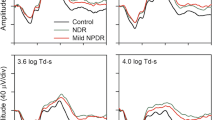Abstract
Photopic, 30-Hz, and foveal electroretinograms were measured in 19 diabetic patients in an experimental study of the effects of short-term Sorbinil (an aldose-reductase inhibitor) on retinal function. Patients were assigned in double-blind fashion to Sorbinil (250 mg/day) or placebo groups and were tested at the outset and after four weeks of therapy. Comparisons (t-test) between the Sorbinil and placebo groups failed to show significant effects of treatment on electroretinograms, although there was a significant correlation within the Sorbinil group between foveal recordings and red cell sorbitol at the end of treatment. Analysis showed that increased foveal electroretinograms were found in patients with low initial retinopathy but not in those with greater retinopathy. Eight patients continued Sorbinil treatment for one year. Again patients improving their foveal measurements had less initial retinopathy than those not improving. This difference was significant after one year of treatment but not at four weeks.
Similar content being viewed by others
References
Yonemura D, Aoki T, Tsuzuki K. Electroretinogram in diabetic retinopathy. Arch Ophthalmol 1962; 68: 19–24.
Simonsen SE. ERG in diabetes. In: Francois J, ed. The clinical value of electroretinography. Basel: Karger, 1968; 403–12.
Biersdorf WR, Grizzard WS, Malone JI. Early detection of diabetic retinopathy in children. Doc Ophthalmol Proc Series 1982; 31: 185–6.
Brunette JR, Lafond G. Electroretinographic evaluation of diabetic retinopathy: sensitivity of amplitude and time of response. Can J Ophthalmol 1983; 18: 285–9.
Bresnick GH, Palta M. Temporal aspects of the electroretinogram in diabetic retinopathy. Arch Ophthalmol 1987; 105: 660–4.
Malone JI, Leavengood H, Peterson MJ, et al. Red blood cell sorbitol as an indicator of polyl pathway activity. Inhibition by Sorbinil in insulin-dependent diabetic subjects. Diabetes 1984; 33: 45–9.
Christensen JE, Varnek L, Gregersen G. The effect of an aldose-reductase inhibitor (Sorbinil) on diabetic neuropathy and neural function of the retina: a double-blind study. Acta Neurol Scand 1985; 71: 164–7.
Biersdorf WR. Temporal factors in the foveal ERG. Curr Eye Res 1982; 1; 717–22.
MacGregor LC, Matschinsky FM. Treatment with aldose-reductase inhibitor or with myo-inositol arrests deterioration of the electroretinogram of diabetic rates. J Clin Invest 1985; 76: 887–9.
Kozak WM, Marker NA, Elmer KK. Effects of aldose-reductase inhibition on the retina and health indicies of streptozotocin-diabetic rats. Doc Ophthalmol 64 (in press).
Kozac WM, Marker NA, Elmer KK. Aldose-reductase inhibition in streptozotocin-diabetic Wistar rats. (This symposium).
Author information
Authors and Affiliations
Rights and permissions
About this article
Cite this article
Biersdorf, W.R., Malone, J.I., Pavan, P.R. et al. Cone electroretinograms and visual acuities of diabetic patients on Sorbinil treatment. Doc Ophthalmol 69, 247–254 (1988). https://doi.org/10.1007/BF00154405
Issue Date:
DOI: https://doi.org/10.1007/BF00154405




